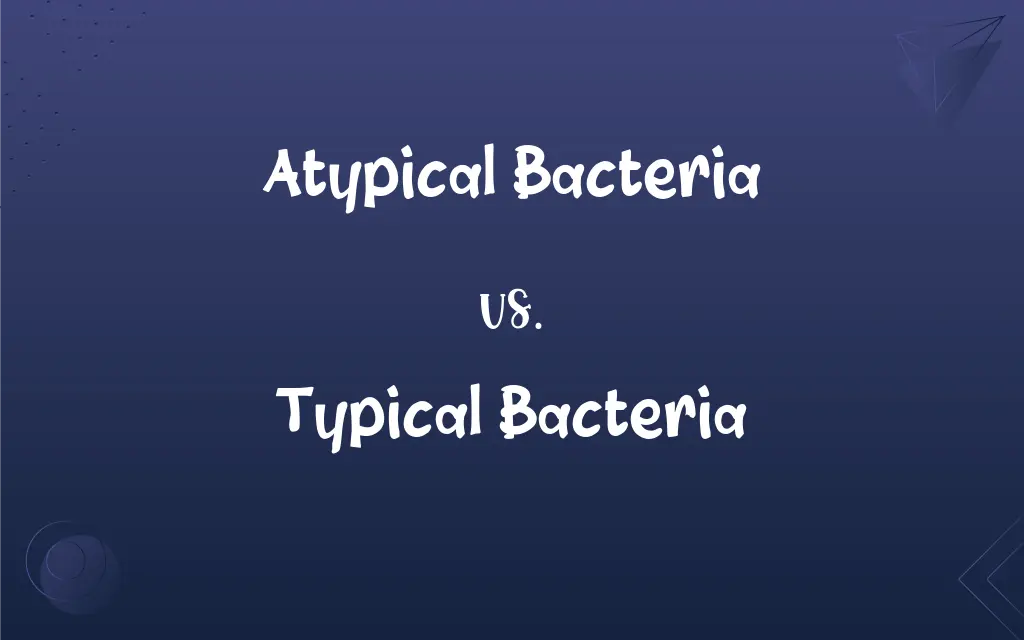Atypical Bacteria vs. Typical Bacteria: What's the Difference?
Edited by Janet White || By Harlon Moss || Updated on October 6, 2023
Atypical bacteria lack a cell wall, often causing atypical pneumonia; typical bacteria have a standard cell wall, classifying them traditionally.

Key Differences
Atypical bacteria represent organisms that don’t align with the traditional characteristics commonly associated with bacteria. These microorganisms tend to deviate in structure, reproduction, or function, thereby distinguishing them from typical counterparts. Typical bacteria, conversely, exhibit classic bacterial characteristics like possessing a well-defined cell wall and conventional reproductive methods, such as binary fission.
Atypical bacteria often do not respond to conventional antibiotics, owing to their unique cellular structures and metabolic processes. This contrasts with typical bacteria, which generally have a susceptibility to a broader range of antibacterial agents, often because of the presence of a traditional peptidoglycan cell wall, which can be targeted by many antibiotics.
In terms of diseases caused, atypical bacteria might result in non-standard symptoms or infections in unusual locations of the body. Typical bacteria generally cause more conventional, anticipated infections and related symptoms, and can often be promptly diagnosed and treated with standard antibiotic therapy.
The classification of atypical bacteria sometimes relates to their morphological characteristics, which can diverge significantly from the conventional forms seen in typical bacteria. Typical bacteria typically exhibit classic shapes such as cocci, bacilli, and spirilla and are frequently categorized based on these physical attributes.
In a medical context, atypical bacteria like Mycoplasma pneumoniae, can lead to atypical pneumonia, which presents with uncharacteristic symptoms compared to pneumonia caused by typical bacteria. Typical bacteria, such as Streptococcus pneumoniae, can lead to typical pneumonia, which presents with predictable, classic symptoms such as a productive cough and high fever.
ADVERTISEMENT
Comparison Chart
Definition usage
Defined by unconventional traits
Defined by standardized characteristics
In a sentence
Atypical bacteria cause atypical pneumonia.
Typical bacteria reproduce by binary fission.
Associated terms
Often associated with unusual or non-standard
Regularly associated with conventional or standard
Noun/Adjective
"Atypical" is an adjective modifying “bacteria”
"Typical" is an adjective modifying “bacteria”
Disease connotation
Frequently linked with non-standard disease presentations
Commonly linked with standard, predictable disease manifestations
ADVERTISEMENT
Atypical Bacteria and Typical Bacteria Definitions
Atypical Bacteria
Atypical bacteria may exhibit unusual morphological characteristics.
Chlamydia trachomatis, an atypical bacteria, shows unique developmental stages, including the infectious elementary body and the reticulate body.
Typical Bacteria
Typical bacteria are usually susceptible to a broad spectrum of antibiotics.
Salmonella, a typical bacteria, can usually be treated with a variety of antibiotics, including ampicillin.
Atypical Bacteria
Atypical bacteria often lack a cell wall.
Mycoplasma, an atypical bacteria, does not possess a cell wall, making it resistant to many antibiotics.
Typical Bacteria
Typical bacteria exhibit a well-structured peptidoglycan cell wall.
Escherichia coli, a typical bacteria, has a well-defined cell wall that is susceptible to penicillin.
Atypical Bacteria
Atypical bacteria might not be Gram-stained.
Mycoplasma pneumoniae is an atypical bacteria, which cannot be visualized using Gram staining due to the absence of a cell wall.
Typical Bacteria
Typical bacteria often cause diseases with predictable, classic symptoms.
Streptococcus pneumoniae, a typical bacteria, causes pneumonia with characteristic symptoms like cough and fever.
Atypical Bacteria
Atypical bacteria often demand specific antibiotics for treatment.
Doxycycline is often used to treat infections caused by atypical bacteria due to its efficacy against these peculiar organisms.
Typical Bacteria
Typical bacteria can usually be categorized as either Gram-positive or Gram-negative.
Staphylococcus aureus, a typical bacteria, is Gram-positive, reflecting its thicker peptidoglycan layer.
Atypical Bacteria
Atypical bacteria can cause diseases with unconventional symptoms.
Legionella pneumophila, an atypical bacteria, can cause Legionnaires' disease, marked by pneumonia and potentially severe kidney dysfunction.
Typical Bacteria
Typical bacteria commonly reproduce through binary fission.
Bacillus subtilis, a typical bacteria, multiplies rapidly through a process known as binary fission.
FAQs
Are typical bacteria always harmful to humans?
No, typical bacteria can be pathogenic or beneficial; for instance, many gut flora are typical bacteria that are essential for human health.
What is the hallmark of typical bacteria?
Typical bacteria exhibit classic bacterial characteristics like having a peptidoglycan cell wall and reproducing through binary fission.
Can atypical bacteria be classified as Gram-positive or Gram-negative?
Atypical bacteria often cannot be categorized as Gram-positive or Gram-negative due to their unique structural characteristics, like lacking a cell wall.
What defines atypical bacteria?
Atypical bacteria are characterized by deviations from conventional bacterial traits, such as lacking a cell wall or causing unusual infections.
Are atypical bacteria common causes of infection in humans?
Yes, atypical bacteria like Mycoplasma and Chlamydia are notable pathogens, causing various infections in humans.
Are typical bacteria a common cause of healthcare-associated infections?
Yes, typical bacteria like Staphylococcus aureus and Pseudomonas aeruginosa are frequent culprits in healthcare-associated infections.
Can typical bacteria be found in healthy human microbiota?
Yes, typical bacteria, such as various Lactobacillus species, are crucial components of the healthy human microbiome.
What structural characteristic often sets atypical bacteria apart?
Atypical bacteria frequently lack a conventional cell wall, setting them apart from typical bacteria structurally.
How do typical bacteria typically reproduce?
Typical bacteria most commonly reproduce by binary fission, a form of asexual reproduction.
How are atypical bacterial infections typically treated?
Atypical bacteria might require specific antibiotics like macrolides or tetracyclines due to their resistance to many traditional antibiotics.
Why can't atypical bacteria like Mycoplasma be visualized with Gram staining?
Mycoplasma, an atypical bacterium, lacks a peptidoglycan cell wall, which is targeted by Gram staining, making it invisible with this technique.
Do typical bacteria always cause typical pneumonia?
While typical bacteria like Streptococcus pneumoniae can cause classic (typical) pneumonia, not all typical bacteria cause this condition.
How are atypical bacterial infections diagnosed?
Diagnosis may involve serological tests, PCR, or cultures, given that atypical bacteria often can't be detected with traditional Gram staining.
Are atypical bacteria always pathogenic?
No, not all atypical bacteria are pathogenic, and some can exist harmlessly in environments like soil and water without causing disease.
Can atypical bacteria be part of the normal human flora?
While many atypical bacteria are pathogenic, some can be present in the human body without causing disease.
Can typical bacterial infections be treated with standard antibiotics?
Often, yes; typical bacteria are generally susceptible to various antibiotics, but resistance can occur.
What is an example of a disease caused by atypical bacteria?
Atypical pneumonia, often referred to as “walking pneumonia,” can be caused by the atypical bacterium Mycoplasma pneumoniae.
Is E. coli considered a typical bacterium?
Yes, Escherichia coli (E. coli) is considered a typical bacterium due to its conventional characteristics like a peptidoglycan cell wall.
Can typical bacteria live in extreme environments?
While some typical bacteria can inhabit extreme environments, extremophiles can belong to both typical and atypical categories.
Can typical bacteria convert atmospheric nitrogen into a form plants can use?
Yes, some typical bacteria, like certain species of Rhizobium, can fix atmospheric nitrogen, aiding plant growth.
About Author
Written by
Harlon MossHarlon is a seasoned quality moderator and accomplished content writer for Difference Wiki. An alumnus of the prestigious University of California, he earned his degree in Computer Science. Leveraging his academic background, Harlon brings a meticulous and informed perspective to his work, ensuring content accuracy and excellence.
Edited by
Janet WhiteJanet White has been an esteemed writer and blogger for Difference Wiki. Holding a Master's degree in Science and Medical Journalism from the prestigious Boston University, she has consistently demonstrated her expertise and passion for her field. When she's not immersed in her work, Janet relishes her time exercising, delving into a good book, and cherishing moments with friends and family.































































